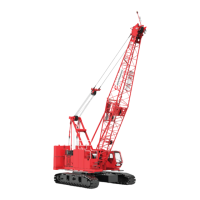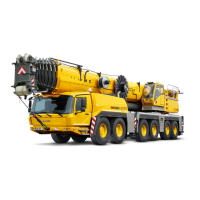Manitowoc Published 09-09-16, Control # 229-09 8-3
MLC650 SERVICE/MAINTENANCE MANUAL UNDERCARRIAGE
Left Reverse Travel Control
See Figure 8-2 and Figure 8-3 for the following information.
When the left travel control handle (J2 joystick) is moved to
the rearward position, the J2 joystick communicates the
travel command to the CCM-10 control module via the CAN
Bus.
If equipped with the optional travel pedals, moving the left
pedal to the reverse travel position sends a corresponding
analog signal to the SCM-00 control module. The SCM-00
control module then communicates the travel command to
the CCM-10 control module via the CAN Bus.
When the CCM-10 control module receives the left reverse
travel command, it sends a corresponding signal to the
IOLC32 and IOSB22 control modules via the CAN Bus.
The IOLC32 begins to ramp up the PWM duty cycle to the A-
side solenoid of the pump 3 EDC. The PWM signal is in
proportion to the speed commanded by the travel control
handle. Increasing the PWM duty cycle increases the pump
swashplate angle, which increases the hydraulic flow from
the A-side of the pump.
From the pump, the flow is routed through the left travel/
drum 1 diverter pilot valve and then into the A-side of the left
travel motors. If high-speed travel mode is selected, the
IOSB22 control module ramps up the PWM duty cycle to the
left travel motors control solenoids to increase the motor
speed until the commanded travel speed is achieved.
The left motor speed sensor and pump 3 pressure
transducer (left track psi) provide the closed loop feedback to
the control modules. The control algorithm uses this
feedback to adjust pump and motor flows to maintain the
commanded travel speed.
Right Forward Travel Control
See Figure 8-1 and Figure 8-3 for the following information.
When the right travel control handle (J2 joystick) is moved to
the forward position, the J2 joystick communicates the travel
command to the CCM-10 control module via the CAN Bus.
If equipped with the optional travel pedals, moving the right
pedal to the forward travel position sends a corresponding
analog signal to the SCM-00 control module. The SCM-00
control module then communicates the travel command to
the CCM-10 control module via the CAN Bus.
When the CCM-10 control module receives the right forward
travel command, it sends a corresponding signal to the
IOLC32 and IOSB22 control modules via the CAN Bus.
The IOLC32 begins to ramp up the PWM duty cycle to the B-
side solenoid of the pump 4 EDC. The PWM signal is in
proportion to the speed commanded by the travel control
handle. Increasing the PWM duty cycle increases the pump
swashplate angle, which increases the hydraulic flow from
the B-side of the pump.
From the pump, the flow is routed through the right travel/
drum 2 diverter pilot valve and then into the A-side of the
right travel motors. If high-speed travel mode is selected, the
IOSB22 control module ramps up the PWM duty cycle to the
right travel motors control solenoids to increase the motor
speed until the commanded travel speed is achieved.
The right motor speed sensor and pump 4 pressure
transducer (right track psi) provide the closed loop feedback
to the control modules. The control algorithm uses this
feedback to adjust pump and motor flows to maintain the
commanded travel speed.
Right Reverse Travel Control
See Figure 8-2 and Figure 8-3 for the following information.
When the right travel control handle (J2 joystick) is moved to
the rearward position, the J2 joystick communicates the
travel command to the CCM-10 control module via the CAN
Bus.
If equipped with the optional travel pedals, moving the right
pedal to the reverse travel position sends a corresponding
analog signal to the SCM-00 control module. The SCM-00
control module then communicates the travel command to
the CCM-10 control module via the CAN Bus.
When the CCM-10 control module receives the right reverse
travel command, it sends a corresponding signal to the
IOLC32 and IOSB22 control modules via the CAN Bus.
The IOLC32 begins to ramp up the PWM duty cycle to the A-
side solenoid of the pump 4 EDC. The PWM signal is in
proportion to the speed commanded by the control handle.
Increasing the PWM duty cycle increases the pump
swashplate angle, which increases the hydraulic flow from
the A-side of the pump.
From the pump, the flow is routed through the right travel/
drum 2 diverter pilot valve and then into the B-side of the
right travel motors. If high-speed travel mode is selected, the
IOSB22 control module ramps up the PWM duty cycle to the
right travel motors control solenoids to increase the motor
speed until the commanded travel speed is achieved.
The right motor speed sensor and pump 4 pressure
transducer (right track psi) provide the closed loop feedback
to the control modules. The control algorithm uses this
feedback to adjust pump and motor flows to maintain the
commanded travel speed.

